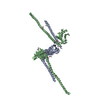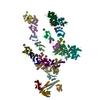+ Open data
Open data
- Basic information
Basic information
| Entry | Database: PDB / ID: 3w03 | ||||||
|---|---|---|---|---|---|---|---|
| Title | XLF-XRCC4 complex | ||||||
 Components Components |
| ||||||
 Keywords Keywords |  DNA BINDING PROTEIN / DNA BINDING PROTEIN /  Coiled-Coil / Coiled-Coil /  NHEJ / DSBs repair / Ku70/80 / NHEJ / DSBs repair / Ku70/80 /  DNA-PKcs / DNA-PKcs /  DNA ligase IV DNA ligase IV | ||||||
| Function / homology |  Function and homology information Function and homology informationFHA domain binding / positive regulation of ligase activity /  DNA ligase IV complex / DNA ligation involved in DNA repair / DNA ligase IV complex / DNA ligation involved in DNA repair /  DNA end binding / DNA-dependent protein kinase-DNA ligase 4 complex / immunoglobulin V(D)J recombination / DNA end binding / DNA-dependent protein kinase-DNA ligase 4 complex / immunoglobulin V(D)J recombination /  nonhomologous end joining complex / protein localization to site of double-strand break / response to ionizing radiation ...FHA domain binding / positive regulation of ligase activity / nonhomologous end joining complex / protein localization to site of double-strand break / response to ionizing radiation ...FHA domain binding / positive regulation of ligase activity /  DNA ligase IV complex / DNA ligation involved in DNA repair / DNA ligase IV complex / DNA ligation involved in DNA repair /  DNA end binding / DNA-dependent protein kinase-DNA ligase 4 complex / immunoglobulin V(D)J recombination / DNA end binding / DNA-dependent protein kinase-DNA ligase 4 complex / immunoglobulin V(D)J recombination /  nonhomologous end joining complex / protein localization to site of double-strand break / response to ionizing radiation / cellular response to lithium ion / 2-LTR circle formation / T cell differentiation / response to X-ray / SUMOylation of DNA damage response and repair proteins / nonhomologous end joining complex / protein localization to site of double-strand break / response to ionizing radiation / cellular response to lithium ion / 2-LTR circle formation / T cell differentiation / response to X-ray / SUMOylation of DNA damage response and repair proteins /  DNA polymerase binding / B cell differentiation / DNA polymerase binding / B cell differentiation /  central nervous system development / Nonhomologous End-Joining (NHEJ) / central nervous system development / Nonhomologous End-Joining (NHEJ) /  fibrillar center / double-strand break repair via nonhomologous end joining / double-strand break repair / site of double-strand break / fibrillar center / double-strand break repair via nonhomologous end joining / double-strand break repair / site of double-strand break /  nucleoplasm / identical protein binding / nucleoplasm / identical protein binding /  nucleus / nucleus /  cytosol cytosolSimilarity search - Function | ||||||
| Biological species |   Homo sapiens (human) Homo sapiens (human) | ||||||
| Method |  X-RAY DIFFRACTION / X-RAY DIFFRACTION /  SYNCHROTRON / SYNCHROTRON /  MOLECULAR REPLACEMENT / Resolution: 8.492 Å MOLECULAR REPLACEMENT / Resolution: 8.492 Å | ||||||
 Authors Authors | Wu, Q. / Ochi, T. / Matak-Vinkovic, D. / Robinson, C.V. / Chirgadze, D.Y. / Blundell, T.L. | ||||||
 Citation Citation |  Journal: Biochem.Soc.Trans. / Year: 2011 Journal: Biochem.Soc.Trans. / Year: 2011Title: Non-homologous end-joining partners in a helical dance: structural studies of XLF-XRCC4 interactions Authors: Wu, Q. / Ochi, T. / Matak-Vinkovic, D. / Robinson, C.V. / Chirgadze, D.Y. / Blundell, T.L. | ||||||
| History |
|
- Structure visualization
Structure visualization
| Structure viewer | Molecule:  Molmil Molmil Jmol/JSmol Jmol/JSmol |
|---|
- Downloads & links
Downloads & links
- Download
Download
| PDBx/mmCIF format |  3w03.cif.gz 3w03.cif.gz | 321.4 KB | Display |  PDBx/mmCIF format PDBx/mmCIF format |
|---|---|---|---|---|
| PDB format |  pdb3w03.ent.gz pdb3w03.ent.gz | 266.3 KB | Display |  PDB format PDB format |
| PDBx/mmJSON format |  3w03.json.gz 3w03.json.gz | Tree view |  PDBx/mmJSON format PDBx/mmJSON format | |
| Others |  Other downloads Other downloads |
-Validation report
| Arichive directory |  https://data.pdbj.org/pub/pdb/validation_reports/w0/3w03 https://data.pdbj.org/pub/pdb/validation_reports/w0/3w03 ftp://data.pdbj.org/pub/pdb/validation_reports/w0/3w03 ftp://data.pdbj.org/pub/pdb/validation_reports/w0/3w03 | HTTPS FTP |
|---|
-Related structure data
- Links
Links
- Assembly
Assembly
| Deposited unit | 
| ||||||||
|---|---|---|---|---|---|---|---|---|---|
| 1 | 
| ||||||||
| 2 | 
| ||||||||
| Unit cell |
|
- Components
Components
| #1: Protein | Mass: 26637.740 Da / Num. of mol.: 2 / Fragment: UNP residues 1-233 Source method: isolated from a genetically manipulated source Source: (gene. exp.)   Homo sapiens (human) / Gene: NHEJ1, XLF / Production host: Homo sapiens (human) / Gene: NHEJ1, XLF / Production host:   Escherichia coli (E. coli) / References: UniProt: Q9H9Q4 Escherichia coli (E. coli) / References: UniProt: Q9H9Q4#2: Protein |  / X-ray repair cross-complementing protein 4 / X-ray repair cross-complementing protein 4Mass: 21058.582 Da / Num. of mol.: 2 / Fragment: UNP residues 1-164 Source method: isolated from a genetically manipulated source Source: (gene. exp.)   Homo sapiens (human) / Gene: XRCC4 / Production host: Homo sapiens (human) / Gene: XRCC4 / Production host:   Escherichia coli (E. coli) / References: UniProt: Q13426 Escherichia coli (E. coli) / References: UniProt: Q13426 |
|---|
-Experimental details
-Experiment
| Experiment | Method:  X-RAY DIFFRACTION / Number of used crystals: 1 X-RAY DIFFRACTION / Number of used crystals: 1 |
|---|
- Sample preparation
Sample preparation
| Crystal | Density Matthews: 8.7556 Å3/Da / Density % sol: 85.9519 % |
|---|---|
Crystal grow | Temperature: 298 K / Method: vapor diffusion, hanging drop / pH: 7.5 Details: 0.1M Tris pH7.5, 2M Sodium formate, VAPOR DIFFUSION, HANGING DROP, temperature 298K |
-Data collection
| Diffraction | Mean temperature: 100 K |
|---|---|
| Diffraction source | Source:  SYNCHROTRON / Site: SYNCHROTRON / Site:  Diamond Diamond  / Beamline: I03 / Wavelength: 0.9763 Å / Beamline: I03 / Wavelength: 0.9763 Å |
| Detector | Type: ADSC QUANTUM 315r / Detector: CCD / Date: Dec 3, 2009 |
| Radiation | Monochromator: Si (111) / Protocol: SINGLE WAVELENGTH / Monochromatic (M) / Laue (L): M / Scattering type: x-ray |
| Radiation wavelength | Wavelength : 0.9763 Å / Relative weight: 1 : 0.9763 Å / Relative weight: 1 |
| Reflection | Resolution: 8.492→49.81 Å / Num. all: 3019 / Num. obs: 2995 / % possible obs: 99.9 % / Observed criterion σ(F): 0 / Observed criterion σ(I): 0 / Redundancy: 6.4 % / Biso Wilson estimate: 926.75 Å2 / Rmerge(I) obs: 0.05 / Rsym value: 0.05 / Net I/σ(I): 12 |
| Reflection shell | Resolution: 8.5→8.8 Å / Redundancy: 6.2 % / Rmerge(I) obs: 0.445 / % possible all: 100 |
- Processing
Processing
| Software |
| |||||||||||||||||||||||||||||||||||||||||||||||||||||||||||||||||||||||||||||||||||||||||||||||||||||||||||||||||||||||||||||
|---|---|---|---|---|---|---|---|---|---|---|---|---|---|---|---|---|---|---|---|---|---|---|---|---|---|---|---|---|---|---|---|---|---|---|---|---|---|---|---|---|---|---|---|---|---|---|---|---|---|---|---|---|---|---|---|---|---|---|---|---|---|---|---|---|---|---|---|---|---|---|---|---|---|---|---|---|---|---|---|---|---|---|---|---|---|---|---|---|---|---|---|---|---|---|---|---|---|---|---|---|---|---|---|---|---|---|---|---|---|---|---|---|---|---|---|---|---|---|---|---|---|---|---|---|---|---|
| Refinement | Method to determine structure : :  MOLECULAR REPLACEMENT MOLECULAR REPLACEMENTStarting model: 2QM4, 1FU1 Resolution: 8.492→49.81 Å / Occupancy max: 1 / Occupancy min: 1 / FOM work R set: 0.59 / SU ML: 2.57 / Cross valid method: THROUGHOUT / σ(F): 0 / Phase error: 44.29 / Stereochemistry target values: MLHL
| |||||||||||||||||||||||||||||||||||||||||||||||||||||||||||||||||||||||||||||||||||||||||||||||||||||||||||||||||||||||||||||
| Solvent computation | Shrinkage radii: 1.11 Å / VDW probe radii: 1.3 Å / Solvent model: FLAT BULK SOLVENT MODEL / Bsol: 0 Å2 / ksol: 0.364 e/Å3 | |||||||||||||||||||||||||||||||||||||||||||||||||||||||||||||||||||||||||||||||||||||||||||||||||||||||||||||||||||||||||||||
| Displacement parameters | Biso max: 154.97 Å2 / Biso mean: 73.3344 Å2 / Biso min: 7.9 Å2
| |||||||||||||||||||||||||||||||||||||||||||||||||||||||||||||||||||||||||||||||||||||||||||||||||||||||||||||||||||||||||||||
| Refinement step | Cycle: LAST / Resolution: 8.492→49.81 Å
| |||||||||||||||||||||||||||||||||||||||||||||||||||||||||||||||||||||||||||||||||||||||||||||||||||||||||||||||||||||||||||||
| Refine LS restraints |
| |||||||||||||||||||||||||||||||||||||||||||||||||||||||||||||||||||||||||||||||||||||||||||||||||||||||||||||||||||||||||||||
| LS refinement shell |
| |||||||||||||||||||||||||||||||||||||||||||||||||||||||||||||||||||||||||||||||||||||||||||||||||||||||||||||||||||||||||||||
| Refinement TLS params. | Method: refined / Refine-ID: X-RAY DIFFRACTION
| |||||||||||||||||||||||||||||||||||||||||||||||||||||||||||||||||||||||||||||||||||||||||||||||||||||||||||||||||||||||||||||
| Refinement TLS group |
|
 Movie
Movie Controller
Controller
















 PDBj
PDBj






